HUMANIZING PUBLIC HOUSING:
Arts, Culture, and Well-Being in the Mixed Income Redevelopment of Seattle’s Yesler Terrace
BY DANYA SHERMAN AND JENNIFER SONG Commissioned by the Seattle Housing Authority
Commissioned by the Seattle Housing Authority

Arts, Culture, and Well-Being in the Mixed Income Redevelopment of Seattle’s Yesler Terrace
BY DANYA SHERMAN AND JENNIFER SONG Commissioned by the Seattle Housing Authority
Commissioned by the Seattle Housing Authority
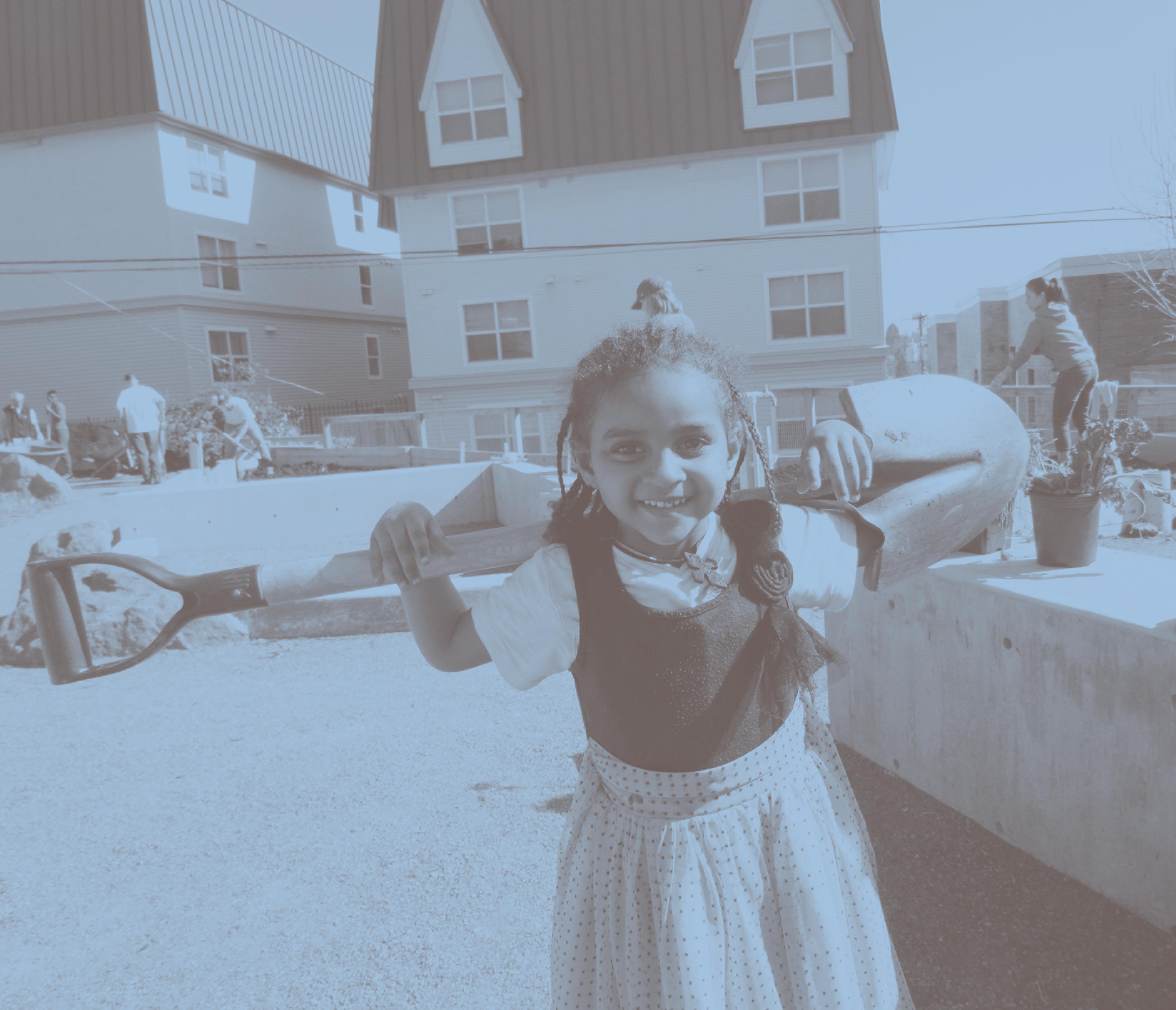
FOR OVER FIVE YEARS , residents at Seattle Housing Authority’s newly rede veloped Yesler Terrace have been working with community-based artists, cultural or ganizers, and educators to learn valuable skills, celebrate their cultural identities, and build a sense of home in their new com munity. These thoughtfully designed ini tiatives were embedded in Seattle Housing Authority (SHA)’s development department to aid in the successful redevelopment of a beloved yet aging public housing commu nity in downtown Seattle. While the pro grams were primarily designed to benefit residents, their integration shines a light on the critical role creative and relational work can also play in promoting culture shift and progress towards racial justice within pub lic housing agencies.1
This paper highlights the value of embed ding arts and cultural programs in managed housing communities, and the way that long-term, relational approaches can sup port a community in its ability to respond thoughtfully to a crisis, in this case the coronavirus pandemic. It documents key features and best practices of arts in hous ing communities, and shares perceptions, outcomes, and implications for residents, organizers, housing authority leadership and staff, funders, policymakers, and creative practitioners. Finally, the report aims to support SHA and other entities working alongside it locally and nationally to define the role that arts and culture can play in supporting the successful redevelopment of mixed income communities.

Generous support from the Kresge Foundation has made Yesler Arts and this report possible, along with many other arts and culture initiatives embedded in national, regional, and local housing and community development entities. Quotes included were collected via semi-structured interviews and anonymous surveys with SHA staff, residents, service providers and artists.

YOUTH POETRY. A MOTHER AND DAUGHTER DANCE FROM THE SAFETY OF THEIR BALCONY TO LIVE DRUMMING PLAYED BY THEIR DANCE TEACHER DURING
A PANDEMIC. NEIGHBORS LEARN TOGETHER HOW
TO MEND THEIR FAVORITE PIECES OF CLOTHING, DESPITE SPEAKING DIFFERENT LANGUAGES.
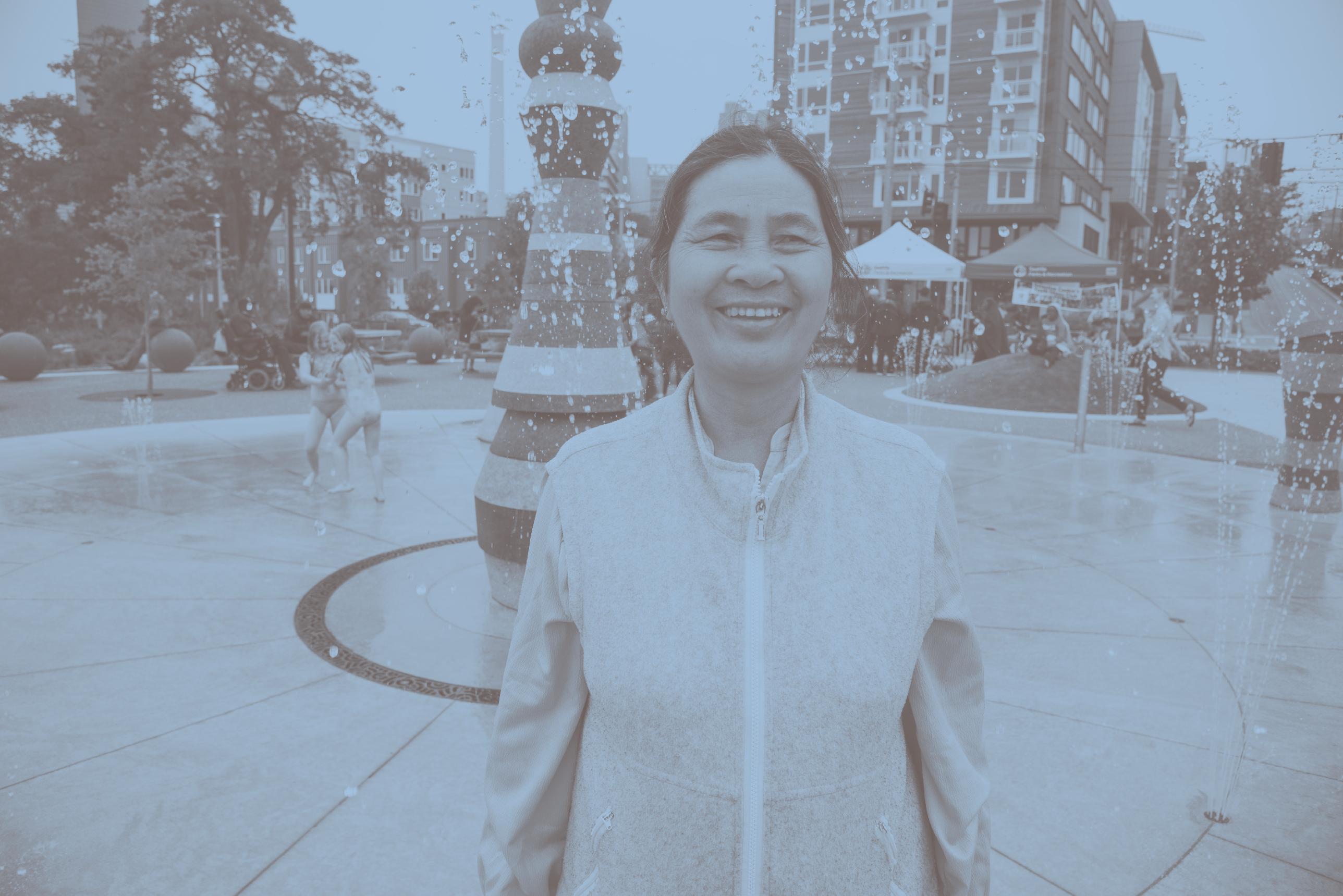
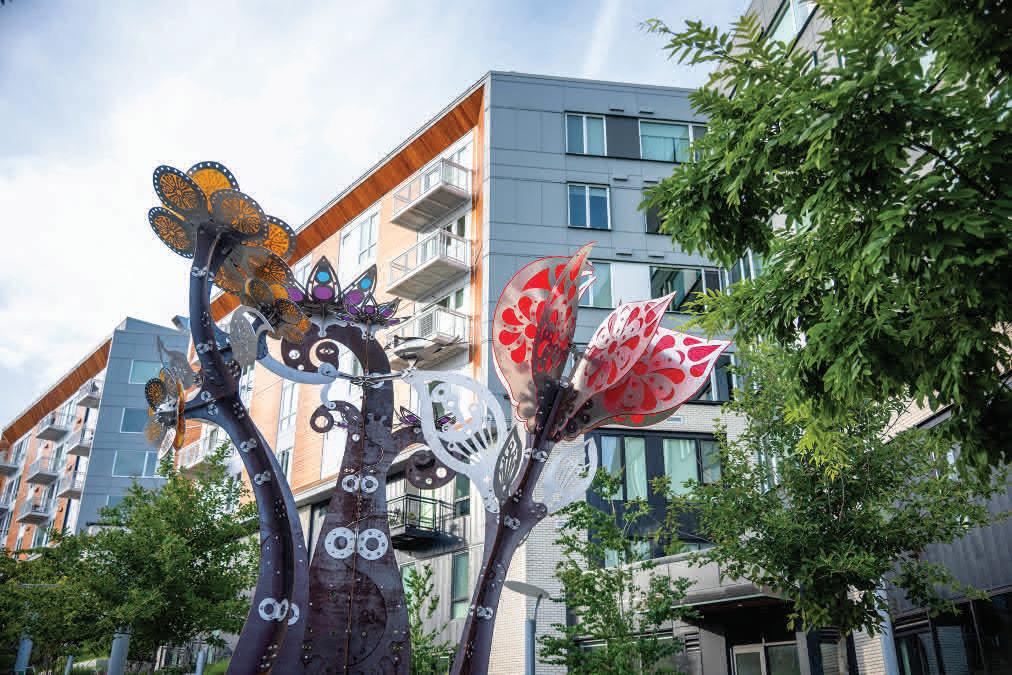
Yesler Terrace is a 30-acre site developed by SHA from 1939-1941 as Seattle’s first publicly subsidized housing community. It is the first racially integrated housing development in the country. Yesler Terrace was unique in many ways, and beloved by many residents because of its low-density garden housing design, its rich cultural traditions, access to services, and the community that was built over many years. However, it was also physically isolated from downtown Seattle by a highway, and suffered from deteriorating infrastructure and a disconnected street grid. As is the case with too many publicly subsidized and/or operated housing in the United States, Yesler Terrace was located in a neighborhood considered by policymakers to be a ‘racially / ethnically concentrated area of poverty’ - where a disproportionate number of lower-income people, immigrants, and communities of color reside without the social services, transit, or infrastructure funding available in other neighborhoods and needed to fully support the community.2
By 2006, it was evident that Yesler’s infrastructure and 561 aging housing units needed to be replaced. SHA began a conversation

with residents, surrounding neighbors, city officials, key partners, and the citizens of Seattle to transform the site. In 2013, the revi talization of Yesler Terrace began. The goals were to develop a dynamic mixed-income community that honors the neighborhood’s history and cultural richness while creating attractive new housing that is affordable to residents across a broad range of incomes. In addition to replacing all 561 original units for families earning no more than 30 percent of the area median income, SHA increased affordable housing opportunities by creating up to 1,100 additional low-income units at Yesler. Private developers will over time add up to 3,000 market rate units and as much as 400,000 square feet of office space. SHA worked to re-integrate the neighborhood with the rest of the city through transit, street grids, and more. The site includes many new parks and open spaces, an upcoming new Kaiser Permanente medical center, a new streetcar line, and expanded services for SHA residents at Yesler aimed at promoting educational achievement, better health, and greater employment opportunity.3

Several governing principles of the redevelopment of Yesler reflect three key national trends in affordable housing: mixed-income redevelopment, cross-sector approaches, and extensive community input.



Mixed-income development is a decadeslong trend in public and subsidized housing in the US. It began to be nationally promoted in the 1990’s and was supported by the U.S. Department of Housing and Urban Development (HUD) through the Hope VI program.4 Hope VI’s intent was to revitalize severely distressed public housing by pooling private and public investment and increasing opportunity for low-income residents through de-segregation by income. Successive federal trends that follow the mixed-income logic include Choice Neighborhoods Initiative (CNI), which Yesler is a part of, the HOME program, and Rental Assistance Demonstration (RAD). The underlying conceptual framework is that mixed-income housing is better for low-income people because expo sure to connections to people with other in comes can aid in the ability to improve their economic opportunity, though research to confirm that point and other more cultural aspects of the benefits is still mixed.
The redevelopment of Yesler Terrace is also considered by many in the national afford able housing sector to be a flagship example of a multi-sector, collective impact approach to affordable housing. While the history of affordable housing in the U.S. began with a more holistic community-oriented ap proach, many projects in the past decades have, out of financial necessity or political motivations, focused only on housing. SHA intentionally pursued partnerships with various City of Seattle departments, many local community development corporations, and other partners to ensure that Yesler residents would have more access to transit, outdoor space, health care, educational programs, workforce development programs, and more. Lastly, SHA worked to include community
consensus and leadership in the process of redevelopment. When redevelopment began in 2006, SHA formed a Citizen Review Com mittee. The Committee was a 20-30-person body made up of residents, community lead ers, small business owners, City of Seattle staff, and affordable housing advocates who met several times per year to solicit broad community input, and then provide key piec es of guidance to SHA. Committee meetings were open to the wider Yesler community and offered translation services in sever al languages. The Committee, among other things, developed four guiding principles in 2007 for Yesler Terrace’s redevelopment: social equity, economic opportunity, envi ronmental stewardship, and one-for-one housing replacement.6 Prioritizing commu nity guidance formed an important backbone for SHA’s interest in integrating relation ship-oriented arts and cultural programming into the redevelopment.
It was in the context of national trends and Yesler’s guiding principles that SHA, considered to be one of the most effective and forward-thinking public housing agencies in the country, solicited funding to support the arts as part of its work to holistically address the challenges of redevelopment. SHA is a public housing agency that is part of the “Moving to Work” HUD program, which critically enables more flexibility with dollars and programs.7
In late 2015, SHA was granted $678,000 from the Kresge Foundation Arts & Culture portfolio and a unique opportunity to infuse arts and culture programs into the Yesler redevelopment process. With the grant funds, SHA hoped to leverage arts and culture strategies to increase social cohesion in the face of radical neighborhood community transformation and establish a healthy network of opportunity at Yesler. An evaluation by Seattle University showed that involving residents in creative placemaking opportunities through multi-layered arts processes can lead to enhanced community identity and character and the celebration of community heritage. After a dynamic first three years, a grant renewal in late 2018 for an additional $300,000 made possible a new two-year cycle of arts programming that drew on the experiences of the previous three years and responded to the current challenges and needs of the Yesler community. In March 2020, the COVID-19 pandemic significantly impacted what artists were able to do. Accordingly, the grant was extended for another six months. The previous five years of relationship and trust-building made it possible for Yesler Arts staff and artists to quickly adapt to new guidelines and residents' needs.


This is a particularly meaningful achievement considering that Yesler’s population, which includes diverse representation and more than 16 languages, is experiencing massive change related to the presence of
market-rate buildings, physical space, and the demographic profile of the community. In addition, the overall landscape in Seattle is changing dramatically in terms of physical development, socioeconomic shifts, and the associated cultural changes. Against the backdrop of trauma associated with the resulting displacement, the redevelopment of Yesler Terrace has captured public imagination as existing and new residents join with community members citywide to rally around opportunities to retain cultural legacies in affordable communities.
While Yesler Arts programs have been crucial in helping to lay the groundwork for successful and healthy community redevelopment, the challenges of transformation will continue as more higher income residents move to Yesler. The private development that is funding the new affordable housing began in 2015, and the number of market-rate housing units outnumbered affordable units in the neighborhood by 2018, When complete in about 2025, Yesler will include 561 replacement units available to households with incomes up to 30% AMI, and approximately 309 units at 60% AMI; 828 units at 80% AMI and 2,305 market-rate units and will be one of Seattle’s densest residential neighborhoods.
“ We realized that art could be different –not just a nice thing, but something even more impactful. We were searching for something to help address how residents can stay engaged, and be powerful.”
SHA DEVELOPMENT LEADERSHIP
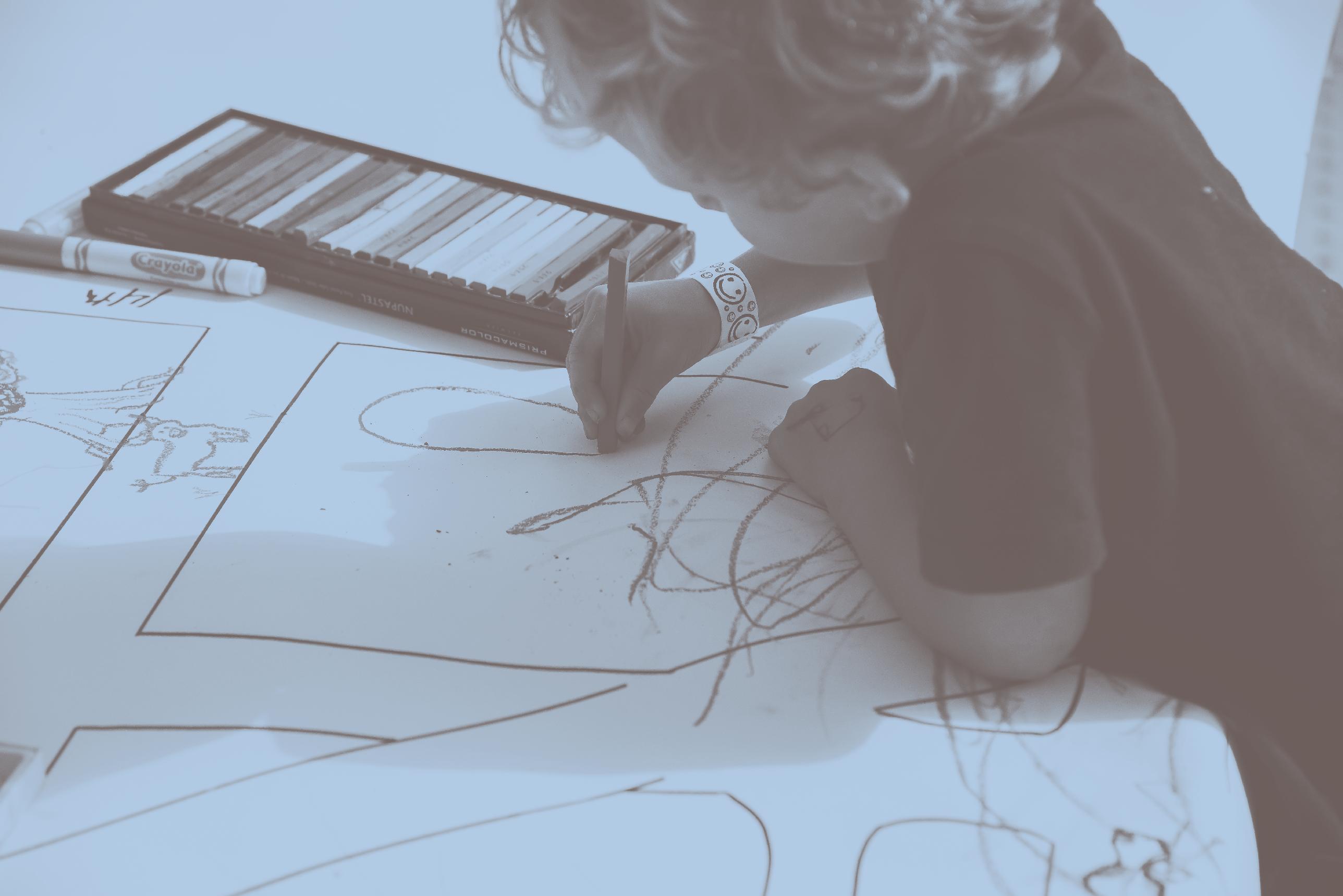
5,577 ATTENDEES AT PROGRAMS
14 ARTISTS/ARTIST TEAMS HIRED
2,634 HOURS OF ARTIST AND PROGRAM STAFF ENGAGEMENT

503 ARTS ACTIVITIES AND PROGRAMS
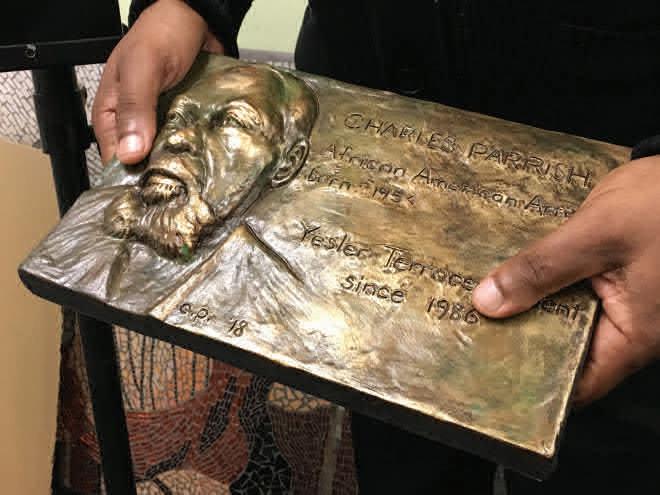

The process of redeveloping Yesler Terrace – as is the case for most redevelopment work – is socially, politically, and emotionally complex for all involved. Many residents were very attached to the community they had lived in, for in some cases decades, and feared involuntary displacement given the history of many public housing agencies and governments doing so across the country.
With the goal of supporting a successful redevelopment effort as defined by the Citizen Review Committee and SHA, the Yesler Arts team approached their work with a relationship-first approach, including hiring an administrator with experience collaborating with artists. Jennifer Song, the arts and culture administrator, built the programming around four key principles (described below), which were not only important in the management of the programming, but required significant creativity on the part of SHA to embody these given the rigid contracting and management systems standard at large public agencies.
In a typical artist commission or selection process, artists are chosen based on criteria such as aesthetic mastery, artistic merit, and conceptual skill. While the level of artistic proficiency was considered in the selection process for Yesler Arts artists as well, there were additional priorities for selection: experience with the Yesler community, responsiveness to community participants and needs, community organizing skills, and ability to amplify existing creative interests and talent. Residents were also asked to provide feedback on artist proposals during the selection process, providing valuable commentary on community “fit.” As a result, artists chosen had deep commitments to the community, or were themselves members of the community, or had experience with

community organizing. Most importantly, the artists were values-aligned: they described and demonstrated their motivation behind the programming as one of support and development of the Yesler community and its residents, rather than just creating an artwork of merit. This required artists to be responsive to what they were hearing from participants and community partners, involve residents in leadership opportunities, and marshal new skills, activities, and program design. Artists were naturally inclined to develop opportunities for Yesler residents to create art based on their own experiences and develop a broad swath of methods for Yesler residents to connect with and express their narrative about the changing community.
CASE STUDY: DANCE AND WELLNESS PROGRAMS FROM WOMEN AND GIRLS
Artist Sumayya Diop led weekly girls’ classes and weekly women's classes with a focus on dance and healing in a safe and supportive environment. The women’s class connected new neighbors, including both SHA and non-SHA seniors living in market rate buildings; and classes for girls, including older teen helpers, focused on community values, sharing, and mentorship. Some participants found their way to class due to Diop’s regular participation in community events and one-off workshops, such as line dancing with Vietnamese seniors, while others were recruited with thoughtful input from SHA service staff and families. Diop, who has decades of experience with Yesler residents, exemplifies deep investment in community. Her standing with staff and residents made her uniquely suited to help participants develop a language and practice of self-care, as they grappled with different kinds of change.
“It is hard to create a standardized approach to arts programs if you want to do authentic community engagement. All artists are interested in different things and not all people at SHA want to work with artists. These are artists we have set up with high expectations… they are touching on really serious issues that need to be addressed in the community.”
SHA ARTS STAFF
Artists’ programming and products were not determined at the time of the proposal, but rather evolved throughout the course of the engagement. From a contracting perspective, artists were hired based on qualifications rather than what they were proposing to build or do. This stands in contrast to the typical selection process for artist commissions in public sector work. It is also significant that artists applied to a call for ‘artists-in-residence,’ which signals to artists that their work would be developed collaboratively over time rather than prescribed from the beginning. Other elements of a process-driven approach include compensating artists for their onboarding, such as attending and listening to community events and meetings with no agenda other than to get to know what’s going on, and other forms of relational
research. Artists are asked to be flexible, experimental, and creative with their approaches - to embrace a “fail fast” model and build up a sense of what residents are looking for and how to translate that into programming over time. This requires a high level of managerial oversight on the part of the administrator. Artists always evolved their work in close collaboration with Song, requiring substantial partnership from an administrator with a large amount of experience working with community-based artists and programming. This close working relationship allowed Song the ability to ensure program design and implementation would complement community needs and institutional protocols while speaking to a complex set of goals that met the needs of myriad stakeholders.
Artist D.K. Pan began his residency focused on providing services to the community that “made the everyday a little better.” Residents and staff requested various small projects, from helping to design and paint a garden shed, to decorating a picnic table with youth, to hosting bingo nights that were eventually turned over to a community leader. From these programs, Pan developed an appreciation for the individual and collective spirit of the community and a heightened awareness of time and change in the neighborhood. New buildings, occupied by both affordable and market-rate housing clients, were opening and change was present in the social and physical landscape of Yesler. In response, Pan offered to residents pop-up portrait sessions with professional quality lighting and equipment. Held at SHA buildings and other neighborhood settings, sessions attracted not only active residents, but those who were unlikely to attend programming. Sitters, who came as individuals, friends, families, and co-workers, dressed in both every day and special occasion outfits and received two portrait copies. Commemorative in nature, the over 500 portraits taken acknowledge the passage of time and a significant period in the changing histories of Yesler residents.

Relationships are the foundation of everything. The community is opening to me because I've spent time there –we have eaten meals, danced, and done karaoke together. I have embarrassed myself trying to learn the dances. They have met my family. [It has been a] real exchange of things.”
SHA ARTIST-IN-RESIDENCE
A third guiding principle for Song was to create programs that complemented and followed existing networks and protocols that existed already in both the Yesler community and SHA at large. This applies to Song’s personal understanding of the program’s stakeholders, as well as the way she guided and supported artists to do their work. Before developing the programming or opportunities for where artists might add value, Song spent 6-8 months at the start of her role getting to know internal SHA leaders and systems. This allowed her to identify where arts programming and other creative interventions would be welcomed and supported by community and SHA alike. Over time, both she and the former SHA Director of Development, Stephanie Van Dyke, worked hard to share the artists’ work, invite staff from all departments to actively participate, and encourage others at SHA to take credit for the good things the arts programming was making space for. For example, Song set aside copies of the Yesler Hello newspaper for SHA staff - even those in procurement and contracts, who rarely get to experience the contributions they make possible. Song also sought out institutional program partners that other arts administrators might never have thought
of, like the agency’s relocation coordinator, construction managers, and property management staff. Finding ways to embed Yesler Arts into multiple institutional and bureaucratic systems helps to bring joy and goodwill to staff.
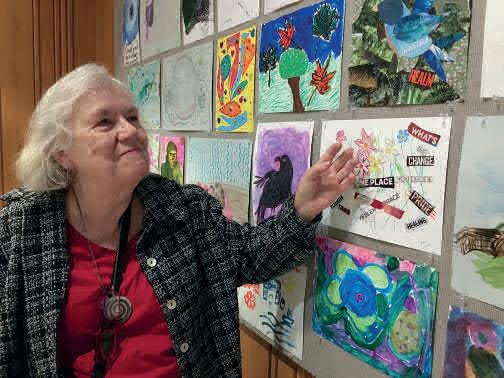
Song likewise insisted that artists also respect community norms and programmatic structures that make up existing life at Yesler. Echoing longstanding community organizing practices, artists were expected to draw on unofficial or official community leaders for guidance and support, to listen to and ask for feedback and partnership from existing community anchors, and remain flexible in their program scope in order to accommodate the changing needs of on-site staff and service providers, education specialists, and residents experiencing their own life changes during redevelopment. An insistence on collaboration also responds to challenges set forth by the community's systems and practices, allowing the programming and the ways it weaves through resident life to evolve more organically. From the artists, this approach requires humility over ego, in order to amplify existing and relatable community cultural dynamics - and helps to fill in gaps that existing social service and housing programs may be too wieldy to address.
Artist Pat Graney worked collaboratively with community service providers to provide story sharing programs with various groups around Yesler. In this program, activities like choreography, sumi ink drawing, and flag making served as prompts to evoke personal memory and reflection amongst the group. Rather than create generic programs, Graney, with group leaders, offered activities and formats tailored for specific audiences, such as a group of Vietnamese elders or mothers taking an ESL class at the local elementary school. Graney’s collaborative work also evolved into other partnerships benefiting the community. For example, Graney organized a community art exhibition for Yesler artists and residents at SOIL fine art gallery in the neighboring business district Pioneer Square and recruited musicians from a local orchestra to perform for residents. Graney’s work is an example of how integrating art into existing culture paves the way for new partnerships that benefit the community directly and expands the existing network of opportunities in a developing neighborhood.
“It takes action to maintain programs like this. It nurtures community, it crosses barriers and brings people together. Especially in a community such as Yesler where diversity is so rich and broad. Making these connections around art helps break down perceptions, judgements and allows friendships to grow.”
SHA STAFF
Lastly, Song employed the practice of telling stories in myriad ways to create cohesion among a wide variety of programs and participants. This has been useful not only for program participants directly, but also for staff and external audiences to understand and support Yesler Arts. At its most basic level, articulating and sharing stories helps individuals and communities empathize and connect with each other. During the redevelopment process, a time of significant change, providing opportunities for residents to articulate and share feelings through culturally specific mediums became an important part of processing. The artists Song brought in deployed narrative creation strategies widely and creatively, from marking the passage of time through pop-up photo studios to documenting personal and community journeys through writing, music videos, and dance. Using multiple media to find accessible ways to share stories is a necessary step in individual and interpersonal development, and particularly within communities that have not had access to as much institutional support, a critical tool for self-advocacy. The art residents create has also been used to help change perceptions of people living in subsidized housing. Since many of
these programs were aimed at helping to ease tensions between older and newer residents across income levels, helping people find middle ground through sharing relatable experiences is critical towards an overall equity agenda. Focusing on nar rative also allowed artists and program leaders to develop common ground - since everyone has stories to share - among participants from various backgrounds. At a programmatic level, focusing on the democratic feeling of storytelling - rather than other aspects of art that can feel less accessible - often helped neighborhood service providers who were less comfortable with artistic practice to find points of connections with artist activities. It also helped SHA staff and program administrators to make sense of the work they were doing in programs, providing more reflective opportunities and giving a greater sense of purpose and meaning. Finally and importantly, providing ways to articulate the benefits of arts programming in broader thematic terms and showcase the value of these arts programs through stories has been critical to supporting the programs through funding, executive leadership buy-in, and external partnerships.

Creative opportunities for residents to tell stories were offered throughout Yesler Arts. In an intensive summer program led by Seattle University art instructors and Seattle Parks and Recreation staff, Yesler youth learned documentary media skills and produced both collaborative and individual features focused on topics relating to their lives and home. Over multiple years and program iterations, students varied their techniques, approaches, and focus, often acting as a community litmus as they challenged neighborhood change, explored the pros and cons of development, and raised larger questions about the future of Seattle in a time of tremendous growth. Similarly, a youth hip hop program led by artist Che Sehyun encouraged young boys to raise questions about family, place, and history through creating and performing hip hop lyrics and music videos. Providing spaces for youth to grapple with change and experience is critical to the long-term well-being of communities and is essential to positive and productive residentengaged development.

Family history albums
Personal albums with photos and text
Jenn Charoni
Sumayya Diop
Pandemic social clubs
Global Girls Village Womens Dance
Courtyard listening sessions
Young Women Rising
Conversation circles
Pat Graney
Community exhibition
Pat Graney, Cheryl Delostrinos VIBE dance
Art Club
Relocation reflections
Online gatherings created for and by residents
Girls dance, writing, and mentorship program
Womens dance and wellness group program
Outdoor performances during the pandemic
Girls dance and peer group program
Art and conversation workshops focused on memories
“What We Treasure: Stories from Yesler Terrace” at SOIL Gallery
Hip hop dance program for youth
Regular lobby-based small group art clubs
Art actions developed with relocating residents
Rachel Kessler
Unit 191: Art House
Family Histories
George Lee Yesler Hospitality Table Megastrobili
Artisans Collective I
Artisans Collective II
Community art and gathering space
Personal journey albums with photos and text
Community-engaged public art work
Community-engaged public art work
Garment skills training
Tailoring, mending, and original projects
Muses Fashion Studio
CUP (Community Upcycling Program)
Pop Up Sewing
D.K. Pan
Acts of Kindness Pop up Portraits
Artist Mentorship
D.K. Pan, Rachel Kessler Community exhibition
Charles Parrish Yesler Leaders
Alessandra Panieri and Dan Barsher Yesler Blossoms
Malia Peoples Yesler Sewing
Kristen Ramirez
The Yesler Hello
Kristen Ramirez, Elisheba Johnson Say Hello
Community videos
Reuse and recycle workshops
Drop-in sewing studios open to the public
Bingo nights and community painting projects
Individual, friend, and family portrait studios
Guidance and supports for SHA artist residents
“YT at SAM” at Sea le Art Museum
Community-engaged public art work
Community-engaged public art work
Weekly skills workshops
Community newspaper and activity guide
Multi-language conversation cards, sidewalk interventions
Collaborative videos showcasing Yesler communities
Che Sehyun
ICEE (Inter Cultural Experiential Education) Hip Hop
Yesler Terrace Futures
Cultural care packages
Yesler youth, Sea le University Youth Media Program
Lyrics and video production program for youth
Youth program featuring zoom and cultural care packages
Culturally-specific care packages for seniors
Youth media and documentary film program
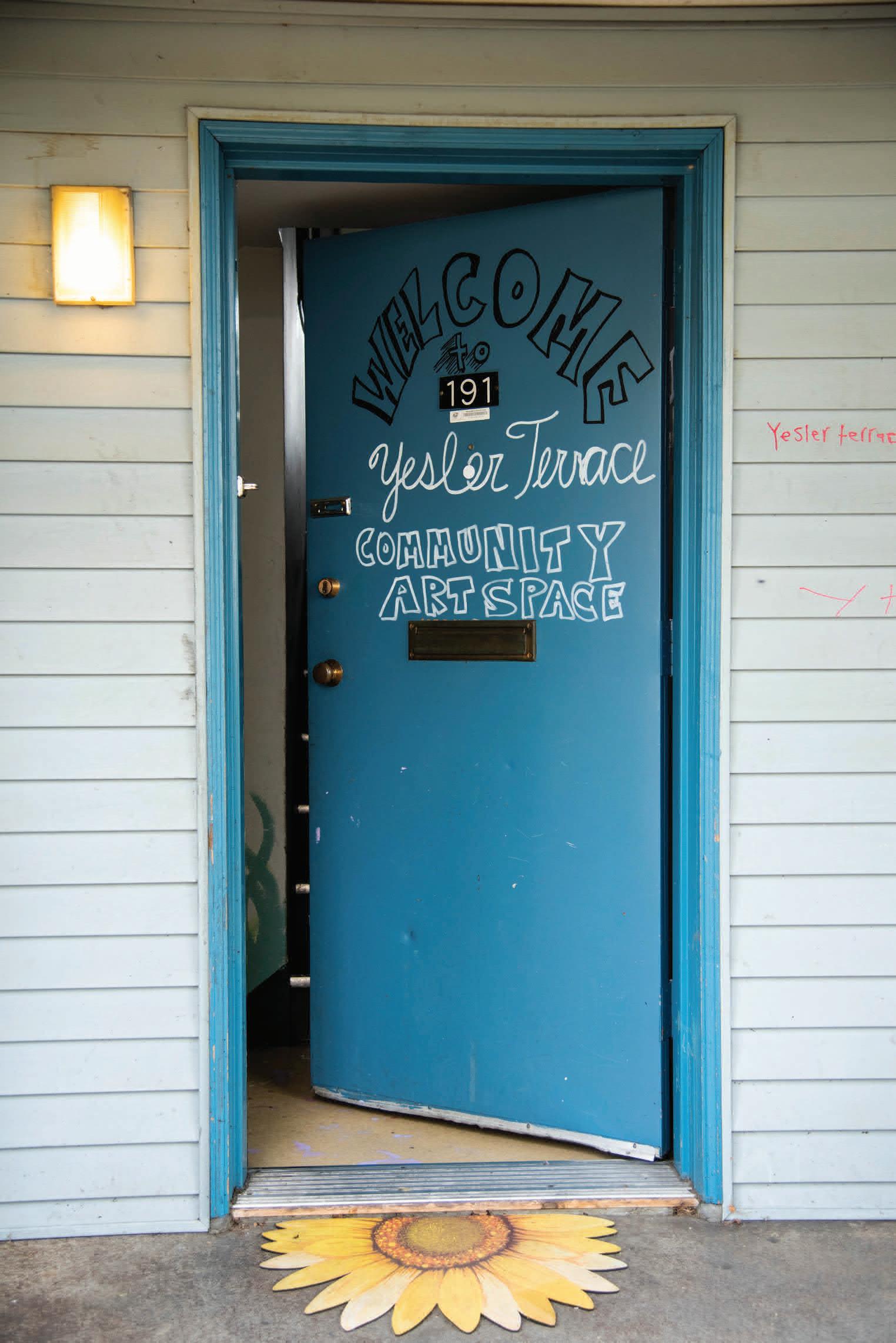

Community-responsive artists working at Yesler over the past several years have developed programs designed to help residents and ease the transition from old to new Yesler, build community in the new development, and more. Through activities like storytelling, dance, and sewing to name a few, artists have helped residents process the transition, share their stories, and create a sense of belonging. Working collaboratively in community, artists and resident participants have developed new forms of community bonding and action, made permanent contributions to the landscape of Yesler, and experimented with multiple methods for presenting stories and envisioning Yesler’s future. The work has been transformative and meaningful for residents, artists, and SHA staff. The analysis of these programs was created by inviting feedback from residents, artists, SHA staff, non-SHA service providers, and other participants in the form of semi-structured interviews at several points throughout the process, surveys in early 2021, and program observation. More details about the data collection and methods are available upon request.

“Hands down, the art programs provided the most valuable social and emotional outlet for residents to engage with the development.”
SHA STAFF
programming enabled arts program staff to center the community in different ways across its initiatives. An understanding of the historical and institutional oppression impacting residents of public housing over generations is critical to recognizing the value and necessity of this work. Public housing residents must work hard overcoming challenges of learning English, finding work despite lack of connections to high-paying work opportunities, accessing high-quality
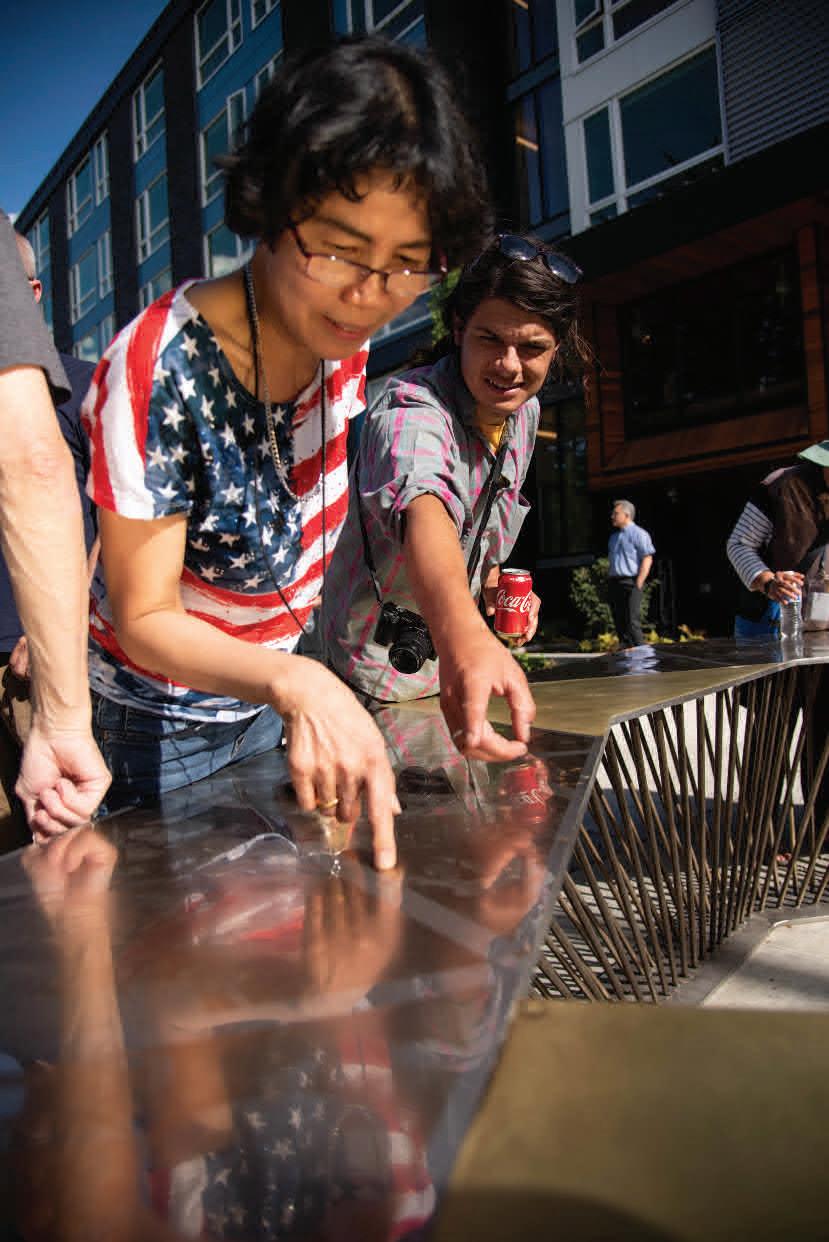
education and social services, and more -burdens that communities of color, low and moderate-income families, and immigrants disproportionately bear because of the way local and federal systems have been created. Yesler residents are no different, and are more likely to have experienced discrimination, involuntary displacement, and other traumatizing patterns than others. Many Yesler residents are refugees or have personal connections to countries experiencing widespread trauma due to war, persecution, and more. This all forms a background to the difficulty and stress of being relocated from their old homes at Yesler and becoming part of a new
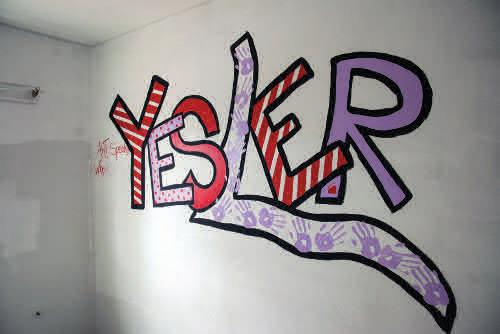
“I don’t feel at home in the new Yesler the same way as I did before. When I was growing up [in the old Yesler Terrace], white people used to say it was dangerous -now they came and took over. Families are nervous that they might get displaced down the road. It is not as friendly anymore… but I am hoping we can one day talk to each other. I would love to know my neighbors.”
SHA COMMUNITY MEMBER
YESLER ARTS IS SUPPORTING THE SUCCESSFUL REDEVELOPMENT OF YESLER TERRACE BECAUSE IT IS:
mixed-income community.

In the context of these challenges, Yesler Arts worked to build a sense of belonging - sometimes called ‘place attachment’ by social scientists and researchers - through experiencing joy, celebrating culture, and strengthening existing or building new relationships. Our research showed that residents felt more connected to each other and the new Yesler as a result of the arts programs. Participants also noted that they felt more connected to other members of the community, like SHA staff, service providers, and the artists themselves. Almost all of the SHA staff members surveyed observed that arts program participants felt more connected to the new Yesler as a result of the programming. Research on similar programs shows that community-based arts participation strengthens trust and solidarity among those participating.8 Nearly all the residents surveyed for this report agreed that they felt more connected to other residents as a result of their participation in the arts programs.
The community-forward approach that Yesler Arts artists and administrators took also provided opportunities for residents to take on leadership roles, which help to develop a sense of agency, control, and belonging. In programs serving youth, the artists recruited and paid (when possible) young adults to be mentors and models to younger generations. Long time Yesler resident and artist Charles Parrish was selected by SHA to create a major public art commission, underscoring the importance of providing community members the opportunity to tell their own story, show pride in community, and reap the economic and social benefits of doing so, whenever possible. Programs like sewing or the Yesler Hello newspaper, to name a few, similarly provided chances for residents to experience the power of creation, both functional and emotional, and in doing so cultivated positive associations with Yesler’s physical and social spaces and communities.
Members of the East African coffee hour group, organized by SHA community services, worked with artist Rachel Kessler to create photo albums that featured their life story. Kessler assisted the women in selecting photographs, sharing stories, and presenting their final albums in a community ceremony. Against a backdrop of neighborhood transition, arts programs play a critical supporting role in recognizing and amplifying benefits of programs like coffee hour and their inherent benefits, such as prioritizing resident voice, preserving culture, and celebrating people's authentic traditions and narratives. As a community development strategy, the family photo album project proved useful during the pandemic, when it was again offered to residents, and property management staff, to help fight social isolation, welcome new residents during a challenging time, and bring families together to share their history.
“Representing Yesler using art is a very beautiful, amazing and fulfilling way of representation.”
SHA RESIDENT
Another way that Yesler Arts was able to support successful redevelopment is by providing caring and culturally relevant outlets for residents to process the enormous amount of change happening around them. While SHA worked hard to ensure that all residents who wanted to move into the new Yesler buildings were able to, some were temporarily relocated, only to move back into a very different neighborhood than what they had left. Many never left the neighborhood, electing to live with long-term construction and development by moving straight into new buildings as they opened, or into other older Yesler Terrace units as an interim step. Staff who managed Yesler’s relocation services discussed the value of the arts programs in both helping to process the complex emotions of redevelopment impacts on residents’ lives as well as the ability to break down some of the bureaucratic barriers of relocation. Several of the artist projects were developed explicitly with this need to process trauma in mind. Kessler’s work in the first three years to occupy an old Yesler home and provide drop-in space for residents to create original art installations and more gave her a clear understanding of how residents were coming to terms with the physical and social changes of redevelopment. This highlighted the issue for SHA staff, other residents, and artists alike, and made open dialogue about it more possible.
Artist Rachel Kessler developed several drop-in programs aimed at responding to residents’ sense of dislocation and a need to process change. Kessler began by offering weekly art clubs in the lobbies of different SHA residential buildings. In moving from garden-level living to multi-level apartment buildings, the community has had to develop new ways to socialize, and regular art clubs, attended by both young and senior visitors, help turn new, unfamiliar spaces into domestic, social ones. The art clubs helped Kessler gain the trust of community members and SHA staff, eventually leading to her Art House project, in which she and residents transformed an unoccupied Yesler Terrace unit - one that had been vacated and was awaiting demolition - into a temporary art gallery and gathering space. The Art House provided opportunities for residents, neighbors, and staff to reflect on community change, honor local histories, and share stories. Residents created art installations and used the space for cookouts, workshops, neighborhood meetings, and more. The outside of the house was also painted with a bell hooks quote in different languages, attracting interest from numerous passersby, who shared with Kessler their thoughts and questions about the redevelopment. In a time when physical space and community identity are in constant flux, programming like art clubs and the Art House define how public or semi-public spaces can be owned and used by residents and offer a sense of agency to residents experiencing extreme, and oftentimes traumatic, change.
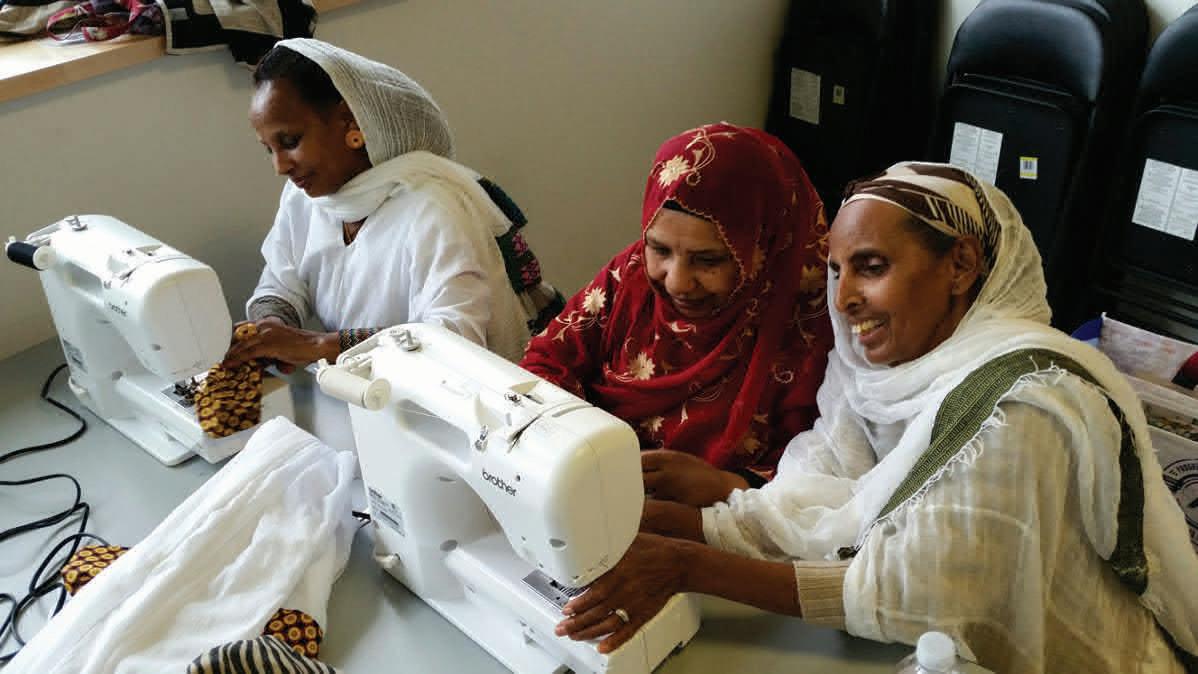
“ The arts were a way for residents to process the impacts of being relocated and seeing massive changes in the community… They gave people an outlet to express misgivings and stress of moving and uprooting. It was a trauma-informed practice. If you are looking at relocation through a trauma-informed lens, arts should be part of that toolbox.”
SHA RELOCATION STAFF
Yesler Arts' integrated and systemschange approach to programming works to establish and institutionalize higher standards of care and living for residents, develop shared values, and help all stakeholders envision better quality of life for all. The nuanced and thoughtful way that artists were selected, developed programming, became embedded in the Yesler community, and supported resident leadership begins to address long-standing inequities based on race, class, ability, and more. Due to the foundational bias and injustices baked into U.S. institutions, working class people, Black people, people with disabilities, women-headed households, and others are more likely to experience economic oppression that requires public
or subsidized housing assistance. As a result, supporting resident leadership and increasing access to services, programming, and other quality of life issues are inherently equity issues. The Citizen Review Committee structure of Yesler Terrace’s redevelopment increases resident voice and representation in the development of Yesler, and the arts programming is an extension of that work. Yesler Arts alleviates community development fatigue, creates more access points into the process, and allows for strategy and experiences to organically generate resident ownership and engagement. Fundamentally, responsive arts programming can help institutions develop systems for residents to take more ownership of their lives.
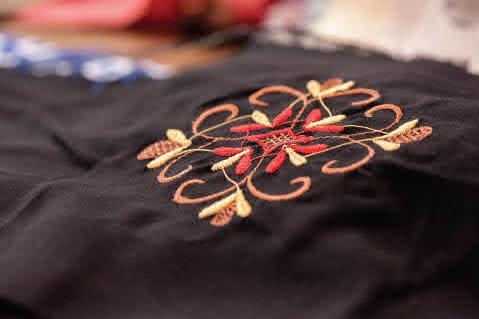
Initiated by nonprofit Muses and then led by artist Malia Peoples, this program included popular sewing workshops for residents with an evolving series of extracurricular activities such as visits to manufacturing sites and sewing supply stores, presentations by small business owners, paid sewing opportunities, and chances to give back to the community in PopUp Sewing Events. Over several years, group participants would form a supportive micro-community despite differences in cultural background, experience level, and personal interest. Driving the program was a commitment to tailor to resident needs. Frequent focus groups, individual check-ins, and paid resident leadership roles led to ongoing changes that were both structural, such as moving the location from a downtown sewing studio to a residential building community room, and curricular, such as transitioning from garment creation to a focus on mending and alterations, which more accurately reflected participant interest. This approach reflects a commitment to addressing injustices so often experienced by low-income populations. Not only should residents have access to programs that provide quality social and economic opportunities, but resident involvement should also be prioritized in myriad ways that give participants more choice, access, and agency -- key building blocks in an equity-driven approach.

Arts programs at Yesler have been an important way to promote internal shifts within SHA as an organization. SHA was open to Yesler Arts’ iterative and relational approach to arts programming, which is indicative of its care for building community holistically, not just replacement housing. The arts programs in turn surprised many SHA staff by making their jobs less strained and connecting them with residents’ needs in less institutionalized ways. Often, property managers and other staff connect with residents to resolve conflicts or complaints through regular meetings or in advisory groups. These interactions can become politicized or fraught, setting up an “us versus them'' dynamic. The spaces that Yesler Arts programming created helped residents and staff connect with each other on more open and friendly terms. Staff found this helped them to get to know residents’ experiences and needs in more holistic ways and understand what needed work from a more empathetic perspective. The property management staff at Yesler articulated how they find this critical point to be connected to the mission of the agency: “This is connected to our core mission of providing decent, safe, and affordable housing, particularly in terms of safety. Residents are able to say they're not a stranger… that hey, I know some people are following up on me.”
Finally, the arts programs helped SHA staff mobilize a caring, culturally appropriate response to the COVID-19 pandemic. The crisis and evolving needs of residents challenged everyone, and SHA systems had to quickly readjust to provide food, information, and more for residents to get what they needed without being exposed to COVID-19. Given these challenges, the existing infrastructure and strong relationships that Song and the artists had
built within the community and within staff allowed them to quickly implement new, re sponsive programs.
This dynamic echoes literature about how community-based arts programs can help strengthen communities and make them more ready to respond effectively to crises of all kinds. As Young and Blatchford describe in a reflection on arts programs at Enterprise com munities: “Culture and creativity are not only forms of identity and expression, they are sur vival strategies and should be considered a vi tal part of any community’s resilience toolkit.”
Produced by artist Kristen Ramirez, the Yesler Hello newspaper is a colorful and high-quality printed quarterly filled with community news and contributions, activities to encourage residents to explore their neighborhood safely, and features by many of Yesler’s service providers. Notable sections of the newspaper included an artist-illustrated map of Yesler, original poetry by youth and seniors, a recipe with tips contributed by a long-time resident, and a scavenger hunt featuring neighborhood plants. Issues of the paper were distributed to SHA households, market-rate buildings, and local businesses. The newspaper presents a positive narrative of community life for and by Yesler residents. For SHA households, an additional insert, translated into multiple languages, was included that detailed news from SHA development and construction, property management, and community services departments. The paper was a key method of communication during the pandemic, when other means of connecting were on hold. This allowed SHA staff to bring more depth and nuance to the agency’s response to the COVID-19 pandemic, providing a very tangible way that arts programs can strengthen public housing agencies’ services.
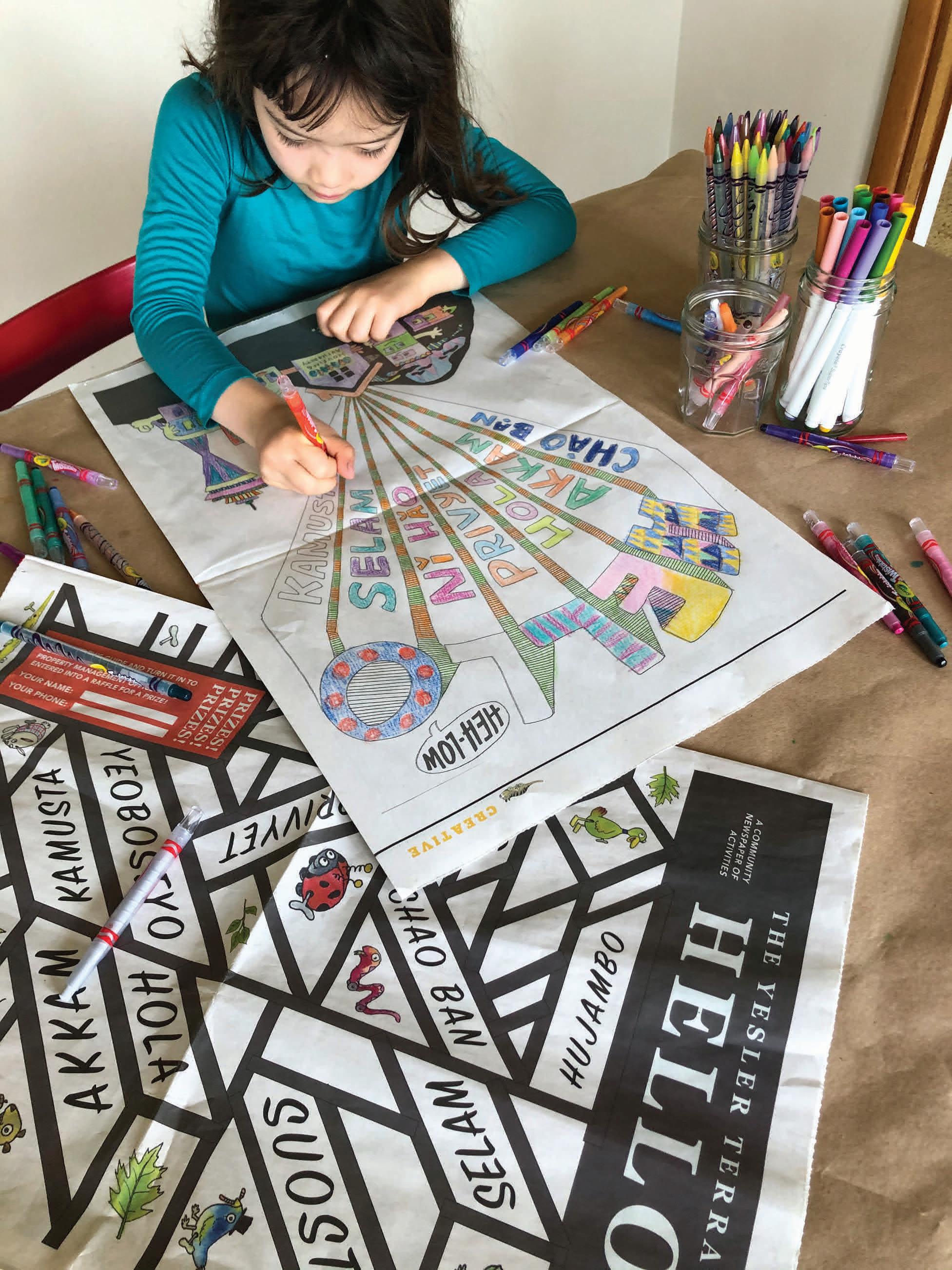
The COVID-19 Pandemic created significant challenges for Yesler residents, and the ability of SHA staff to respond. Thanks to an accumulation of community know-how built up over years of programming, strong relationships with on the ground staff working to provide essential resources to residents, and general trust from SHA staff and service providers to make thoughtful and practical programming choices, the artists were able to quickly respond to community needs with new or revised projects.
• Artist Kristen Ramirez produced a quarterly printed newspaper full of community-created content distributed throughout Yesler buildings.
• Artist Jenn Charoni implemented pandemic social clubs that helped connect small groups of friends and neighbors to one another.

• Artist Sumayya Diop held weekly balcony listening sessions where she sang and played drums out doors in different SHA courtyards.
• Artist Che Sehyun, inspired by SHA’s food distribution services, organized cultural care packages, full of comfort objects and culturally specific food.
• Artist Malia Peoples created fabric arts kits, held weekly Zoom sewing sessions, and mentored residents who were paid by SHA to sew masks for SHA staff responders during the early months of the pandemic.
“SHA is constantly wrestling with a fundamental question of affordable housing providers: How do we help people get out of poverty? And how do we help people who may not get out of poverty live a meaningful life? Things that help our system provide more autonomy for residents are very meaningful in this respect.”
SHA DEVELOPMENT LEADERSHIP
SHA staff, artists, and Song and her team worked hard to create a consistent presence over five years of programming, and their nuanced, unique, and thoughtful approach to artistic activity supported the Yesler community in many ways. Along the road, many hurdles were encountered. Below, several of the key challenges are described in an effort to help others seeking to do similar work learn from this experience.
The newly redeveloped Yesler was created for a functional reason -- to replace aging housing and infrastructure that could no longer be maintained with new housing for the low-income residents, expand affordable housing, and create a mixed-income community. The variety of cultures, languages, and life experiences of people at Yesler is wide, creating a complex and polyglot environment. On top of that already existing level of diversity that can make forming connections challenging, Yesler residents have been living amongst the construction of many new amenities and sites adjacent to their new homes. Another compounding factor is that the new Yesler community is mixed-income, with market-rate housing tenants primarily living in low occupancy rental units with high turnover. Differences in culture, access to opportunities, and other dynamics as a result of extreme class divisions have contributed to feelings of mistrust or apprehension. For example, enrollment at local schools is up, indicating more people in the neighborhood and a sense of fewer resources
to go around. There are new families on the playground and in the parks with different expectations and cultural habits. There are fears in the community about how new residents may shift the culture and resources of the schools.
Administrators and artists working to build community amidst these conditions must take a finely tuned approach, with consideration for the lack of familiarity residents have with each other, emotional turmoil related to change, and sometimes conflict and misunderstandings that the above conditions can cause. Additionally, when turnover occurs among staff and residents, artists and administrators are sometimes working with different groups of people, making it difficult to create learning plans with projects that build on each other. One takeaway from these dynamics is that while expectations about what can be accomplished should remain high, care and empathy for community dynamics may impact artists’ and service providers’ ability to accomplish programmatic goals.

“ These parents, their kids don't even go to the same schools [as our kids do]. I don't blame them if you can afford a private school. I just would love to see some transition between the communities so there's no wall.”
YESLER COMMUNITY MEMBER, SPEAKING ABOUT RESIDENTS OF THE MARKET-RATE BUILDINGS
Building trust in an evolving and dynamic environment
The Seattle Housing Authority, like many other large public agencies, is subject to a high degree of regulation and has developed careful systems as a result. While these systems are useful for ensuring the safety of their buildings, taking care to avoid nepotism, and other reasons, the way systems have been designed make hiring and contracting with artists difficult. For example, all contractors working with SHA are required to carry various kinds of insurance. These requirements are very necessary for building contractors, but have relatively high costs associated with them and are not usually in place for self-employed contractors like inde-
is also an onerous task, for good reason: to ensure that contractors are not chosen for the wrong reasons. But the work required to submit a proposal and move through the process - in addition to meeting the requirements needed to be selected as a community-based artist - is time consuming, confusing for those not familiar with this kind of paperwork, and can therefore be prohibitive. All of these dynamics required a high level of involvement from Song in order to support artists moving through the process, while also working internally with SHA contracting to understand what flexibility may exist.

Several of the artists and SHA staff described their interest in helping to build space for residents themselves to define, guide, or even lead arts commissions and programming. This interest evolves naturally from the approaches described above that are foundational to the Yesler Arts program -- but difficult in practice to enact because of many of the challenges shared here. There is also a structural tension present in managed housing: SHA supports resident leadership and organizing in order to ensure housing, services, and programs are as
useful as possible, but also must play the role of landlord - collecting rent, navigating conflict that arises from so many people sharing space, and more - creating tension at times. Song and the artists did their best to navigate productively between SHA protocol and expectations and resident leadership, and noted that with more time, translation, and other considerations described in the next section, the interest and support for resident leadership and ownership of programs could be more fully gauged and realized.
In 2016, artist George Lee and artist team Alessandra Panieri and Dan Barsher were commissioned to create respective permanent artworks for the Yesler redevelopment. The artists collaborated with SHA staff and residents, third party architects and planners, developers, and construction teams to identify sites and implement public sculptures. Challenges along the way included issues around sub-contracts, design approvals, permitting, and budgeting, but SHA’s flexibility and willingness to engage in a non-prescriptive process not only created more unforeseen opportunities for production but allowed for more authentic connections to the community. For example, Lee was awarded an additional commission for the Yesler Hospitality Table, a community-inspired design that was paid for with funds originally earmarked for a prefabricated picnic table. Panieri and Barsher, in creating their sculpture Yesler Blossoms, developed a close working relationship with Andersen Construction, a contractor on site, resulting in pro bono labor and other donations, almost tripling the artists’ budget. In both cases, the artists used the extended timeline to solidify authentic community relationships to their project’s advantage. Lee’s Hospitality Table features original photos of residents etched into its surface, and Yesler Blossoms was informed by art workshops and interviews conducted by the artists. The longer timeline, and the space it made for greater creativity, advocacy, and patience, proved instrumental to the works being reflective of the residents.

Reviewing the approaches, challenges, and findings foundational to Yesler Arts led to the following implications, which are important to consider for future housing entities wishing to learn from or build on this work.
Arts programs embedded in managed housing communities should consider:
1 Aligning with the best practices of the agency, which makes for a stronger, more sustainable program and one that stands to impact the agency’s goals longer term.
2 Replicating the approaches Song took (described above): Hire community-driven artists; let process drive, not product.
3 Embedding arts administration and management into departments not typically associated with this kind of work, including property management, operations, development, and policy.
4 If possible, planning for a long-term (5 to 10 year) approach to arts programming development and implementation, including ample time for the full phase of programming from community research and buyin to achieving desired outcomes.

5 To ensure long-term sustainability, contracting with an arts organization to endow and manage the program in order to maximize flexibility and accessibility without changing institutional guidelines.
6 Providing training for artists in therapeutic and trauma-informed practices.
7 Expanding programming to all housing communities; its benefits are not just tied to redevelopment.
8 Identifying benefits and ways of involvement in the arts programs for staff who may not be directly involved in the management of the programs.
In March 2021, Song’s position with SHA and related programming (which had previously been supported by Kresge grant funds) became funded through internal budget allocations and proceeds from Yesler land sales. This continuation allowed Song to extend programming, as well as begin to consider what ongoing support for artist programming could look like within SHA. Song is considering what kind of work is needed to further address some of the challenges described above, and if there are ways to set up SHA for ongoing integration of the arts into future redevelopment projects or existing managed housing properties. One continuation could focus on relationship building between existing and new Yesler residents of varied incomes. This may center around using shared spaces to create meaning and value around connecting with neighbors and community members, finding common interests and points of connections through the arts, building strong resident leadership networks, and continuing to build belonging and identity formation around Yesler as a shared space. All of these things work towards a long-term culture of belonging and pride of place, which will in turn continue to contribute to social cohesion amongst seemingly disparate communities.
Given the enormous impact these programs have had at Yesler for both residents and staff, other public housing agencies may wish to support similarly designed programs. While many associated organizations, such as major national community development intermediaries, currently have initiatives focused on integrating arts to support their missions, local public housing agencies have been slower to take up the mantle. We hope that this paper can provide guidance and make it easier for other public housing agencies wishing to support similar initiatives.

“I would love to see Yesler Arts continue and expand. I think that it really does take time for people to build relationships with arts programming, and as those relationships grow so does a sense of safety and creative liberation — the things that make arts programming truly transformative in neighborhoods.” YESLER SERVICE PROVIDER
The mission of the Seattle Housing Au thority is to enhance the Seattle commu nity by creating and sustaining decent, safe and affordable living environments that foster stability and self-sufficiency for people with low incomes. In a variety of housing program types, SHA provides long-term, low-income rental housing and rental assistance to more than 37,000 people, representing nearly 19,000 households, in the City of Seattle. SHA owns and operates approximately 8,500 apartments and single-family homes at nearly 400 sites throughout the city. Additionally, SHA administers more than 10,000 Housing Choice Vouchers, enabling low-income tenants to receive rental assistance with other landlords in Seattle. Nearly 80 percent of those SHA serves are children, elderly or disabled. One in 10 students enrolled in Seattle Public Schools lives in SHA-supported housing.
SHA focuses not just on providing housing but on holistic community-building. To provide critical services like employment connections, recreational activities, education, healthcare, and more, it builds partnerships with other organizations and takes a multi-sector approach to redevelopment and management.
SHA is an independent public corporation. The majority of SHA's funding is federal, through the U.S Department of Housing and Urban Development (HUD). Other income includes rent revenue and non-HUD public and private grants.
DANYA SHERMAN (she/her/hers) is the Founder and a member of Sherman Cultural Strategies, a Boston-based consulting firm that brings teams together to support the evolution of values-driven partners across the U.S. through strategy, research, writing, and facilitation at the intersection of community development, the arts, and social justice. For five years Danya was a Senior Consultant on the Research Strategies team at ArtPlace America, and continues to teach courses on creative community development and design field building activities aimed at integrating the arts into equitable community development. She previously spent seven years as the Founding Director of Public Programs, Community Engagement, and Education at Friends of the High Line. Her writing and journalism has been published in Next City, Shelterforce, and by Rutgers University Press. She has addressed audiences at Providence Athenaeum, the Boston Society of Architects, the New School, Drexel University, and elsewhere on equitable urban development, community engagement, public space, and the cultural dimensions of public transit. Danya holds a Master’s in City Planning from MIT and a Bachelor of Arts from Wesleyan University (CT). www.danyasherman.com
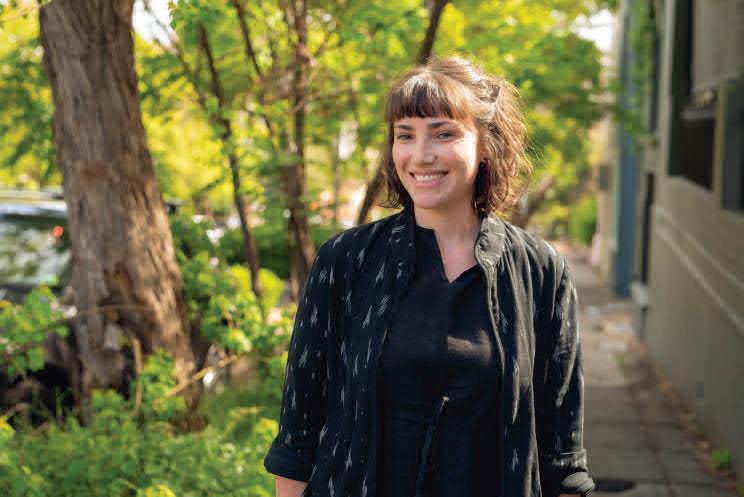
JEN SONG (she/her/hers) oversees the Seattle Housing Authority’s arts initiatives at Yesler, where she sees the ways in which arts and culture activities can drive social change and transform institutions, communities, and individuals. Formerly, Jen worked in the fields of museum and community-based education for over 17 years. She was most recently the Associate Director of Education at the New Museum of Contemporary Art in New York City and has also held positions at the Museum of Modern Art and Brooklyn Museum. Jen has taught seminars in community-based arts at New York University, the City University of New York, and Teachers College and has published on topics such as engaging in dialogue on race, class, and culture through the arts. Jen earned a bachelor’s degree in art history from Columbia University and has a master’s degree in visual culture and theory from New York University.

Research for this paper drew from a literature review, observation and analysis of Yesler Arts programming, community meetings, an analysis of artist program reports, more than 15 semi-structured interviews with SHA staff, artists, Yesler residents, community members, and others, and an analysis of survey responses from more than 30 SHA staff and residents. Quotes and case studies throughout the paper have been drawn from interviews and surveys and are shared anonymously. Sherman first learned about Yesler Arts’ work when she and Song organized a 2-day workshop for three visiting housing entities to learn about the program, which was hosted by ArtPlace America, Seattle Housing Authority, and NeighborWorks America. Sherman had planned to visit Yesler to continue observing programming at least three times throughout the course of the second round of programming, but due to the Covid-19 pandemic was only able to visit once during the second cycle. In addition, resident interviews and surveys were requested and conducted only when needed and with great sensitivity given an interest in being as little a burden as possible to the community.
Song and Sherman collaborated to create this paper, but the analysis, findings, challenges, and implications were completed by Sherman and intended to bring an outside perspective to the work.
The following people generously contributed by sharing their experiences over the course of one or more interviews with the authors. Thank you!
FITSUM ABRAHA, Senior Property Manager, Yesler, SHA
ABDULLAHI ABDI, Yesler Community Leader
SUMAYYA DIOP, Artist-in-Residence, Yesler
STEPHANIE VAN DYKE, Former Director of Development, SHA
JARED JONSON, Former Policy and Program Manager, SHA
RACHEL KESSLER, Artist-in-Residence, Yesler
SVEN KOHLER, Yesler Relocation Specialist, SHA
TERA OGLESBY, Strategic Advisor II, Employee Training, Career Development & the RSJI (Race and Social Justice Initiative), SHA
DAVINA O’CONNOR, Property Manager, Yesler, SHA
KRISTIN O’DONNELL, Yesler Resident and Community Leader
KRISTEN RAMIREZ, Artist-in-Residence, Yesler
CHE SEHYUN, Artist-in-Residence, Yesler
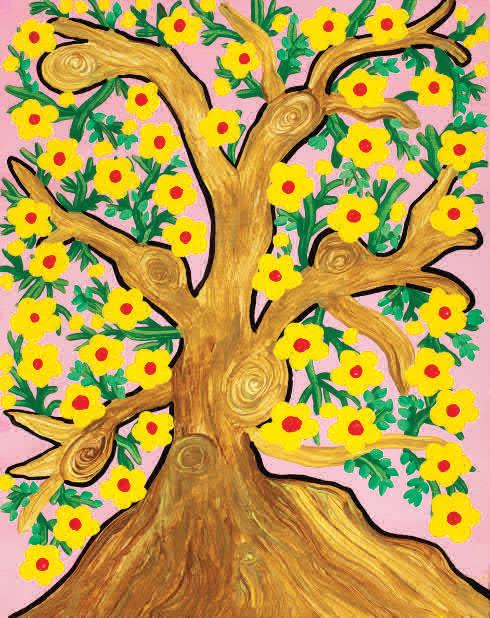
JENNIFER SONG, Arts Coordinator, SHA
RACHAEL STEWARD, Deputy Director, Department of Housing Operations, SHA
BEN WHEELER, Yesler Community Builder, SHA
DEBORAH VANDERMAR, SHA Community, Member and Sewing Program Leader
OLGA WILSON, Yesler Resident
1 By relational, the authors mean that Yesler Arts sought a people-first approach to program development, implementation, and refinement. Rather than the usual more hierarchical approach to program design and development, Yesler Arts prioritized deep listening, open communication and feedback, and following the lead of the communities at Yesler.
2 2017 City of Seattle and Seattle Housing Authority Joint Assessment of Fair Housing, Accessed April 2021 at RacialDisparityDataReport_Nov2015.pdf
3 Seattle Housing Authority website, Accessed April 2021 at seattlehousing.org/about-us/redevelopment/redevelopment-of-yesler-terrace
4 National Low Income Housing Coalition, March 1, 2007. Accessed April 2021 at https://web.archive.org/web/20070927203142/http://www.nlihc.org/detail/article. cfm?article_id=2772&id=46
5 Levy, Diane, Zach McDade, and Kassie Dumlao, “Effects from Living in MixedIncome Housing Communities for Low Income Families: A Review of the Literature.” The Urban Institute, November 2010, Accessed April 2021 at h sites/default/files/publication/27116/412292-Effects-from-Living-in-MixedIncome-Communities-for-Low-Income-Families.PDF
6 Seattle Housing Authority website, Accessed April 2021 at seattlehousing.org/sites/default/files/YTGuidingPrinciples.pdf
7 The U.S. Department of Housing and Urban Development, accessed April 2021 at https://www.hud.gov/mtw/
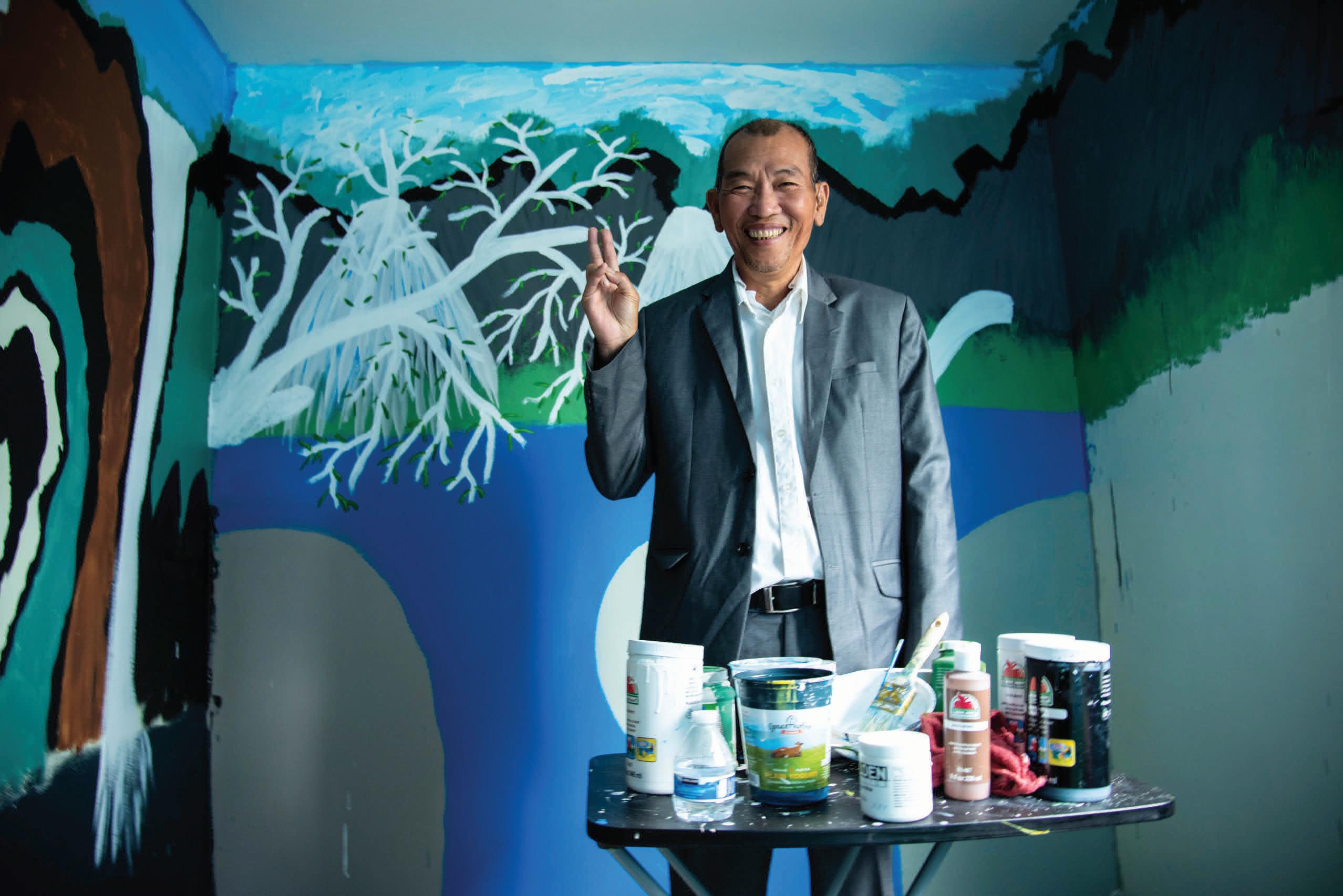
8 Wali, Alaka, Rebecca Severson, and Mario Longoni. “Informal arts: Finding cohesion, capacity and other cultural benefits in unexpected places.” Chicago Center for Arts Policy at Columbia College, 2005.
9 Blatchford, Laurel and Nella Young. “Culture and Creativity Are Fundamental to Resilient Communities.” Federal Reserve Bank of San Francisco Community Development Innovation Review, November 13, 2019. Accessed online April 2021 at https://www.frbsf.org/community-development/publications/ community-development-investment-review/2019/november/culture-andcreativity-are-fundamental-to-resilient-communities
Page 4 and 5
Top photo: Che Sehyun
Page 9
Photo: D.K. Pan
Page 11
Top photo: Che Sehyun
Page 11
Bottom photo: Yesler Terrace
Youth Media Program
Page 17
Photo: Hannah Letinich
Page 23
Photo: Che Sehyun

